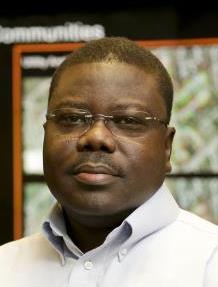
Dr. Olufemi A. Omitaomu, Senior Research Scientist
ORNL Computational Sciences and Engineering Division
September 12th, 2014, 2:30 – 3:30 PM
410 John D. Tickle Engineering Building
Dr. Olufemi A. Omitaomu is a Senior Research Scientist in the Computational Sciences and Engineering Division at Oak Ridge National Laboratory (ORNL) and an adjunct faculty in the Department of Industrial and Systems Engineering at the University of Tennessee, Knoxville. Prior to joining ORNL in October 2006, he was a Post-Doctoral Research Fellow in the Advanced Optimization Laboratory at McMaster University, Hamilton, Canada. He received a B.S. degree in Mechanical Engineering from Lagos State University, Nigeria in 1995; an M.S. degree in Mechanical Engineering from University of Lagos, Nigeria in 1999; and a Ph.D. degree from the Department of Industrial and Systems Engineering at the University of Tennessee, Knoxville in 2006. He was a Project Engineer with Mobil Producing Nigeria between 1995 and 2000. His research interest includes modeling, analyzing, and designing sustainable energy systems; power generation facilities planning; and predictive analytics for power systems reliability and energy supply chain resiliency. His research has been funded by the Department of Energy (DOE), Defense Advanced Research Projects Agency (DARPA), National Geospatial-Intelligence Agency (NGA), Electric Power Research Institute (EPRI), and the Department of Homeland Security (DHS).
Seminar Abstract: The renewed interest in siting new nuclear power plants in the United States (for example, the Vogtle project in Georgia) and the decision to halt work on a permanent nuclear waste repository site at Yucca Mountain in Nevada have called for new strategies for managing nuclear waste. Consequently, in March 2010, the U.S. Department of Energy (U.S. DOE) charged the Blue Ribbon Commission on America’s Nuclear Future to review policies for managing the back end of the nuclear fuel cycle and recommend a new plan. The Fukushima Daiichi nuclear disaster of March 11, 2011 in Japan added yet another dimension to the issue of nuclear waste. The Blue Ribbon commission submitted its final report on January 26, 2012; and their recommendations include: (1) the development of basic initial siting criteria that will ensure that time is not wasted investigating sites that are clearly unsuitable or inappropriate for siting centralized facilities; (2) the encouragement of interest from a large variety of communities that have potentially suitable sites; and (3) the development of one or more consolidated storage facilities. In this talk, we will discuss our work on facility location models that could help the U.S. DOE achieve these three recommendations. We will conclude the talk by highlighting other ongoing research efforts geared towards achieving a more resilient and sustainable energy system.